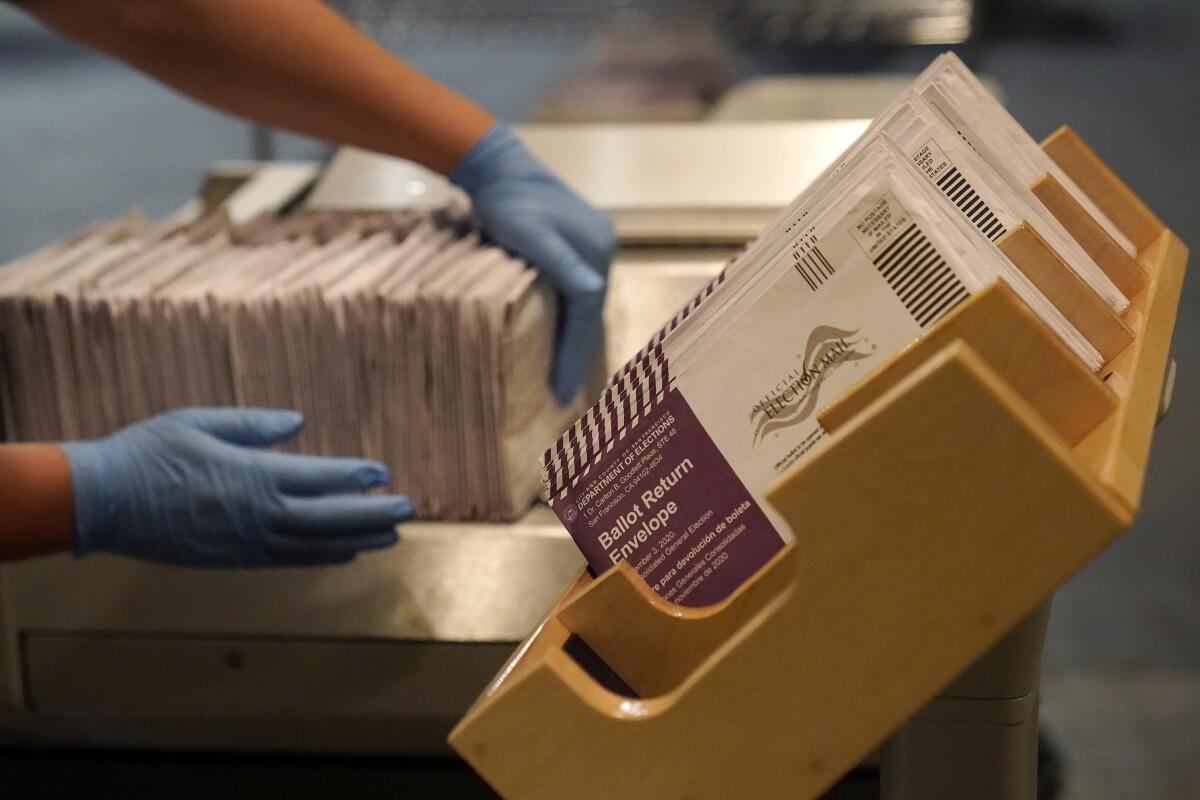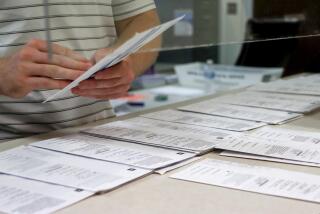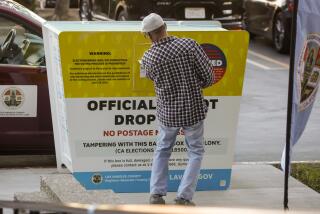California’s universal voting by mail becomes permanent

California’s pandemic-inspired move toward mailing a ballot to every registered, active voter will become a permanent part of the state’s political landscape, an embrace of an extended and flexible voting process instead of the traditional focus on a single day of voting in person.
Gov. Gavin Newsom’s signature Monday on Assembly Bill 37 makes California the eighth state in the nation with a law on the books requiring every voter to be mailed a ballot. The new law is part of an evolution of voting in the state over the last two decades, an effort to provide voters more options for when and where to cast their ballots.
“Data shows that sending everyone a ballot in the mail provides voters access. And when voters get ballots in the mail, they vote,” Assemblyman Marc Berman (D-Palo Alto), the bill’s author, said during a Senate committee hearing in July.
The law takes effect in January, providing a symbolic counterweight to a handful of other states where access to voting could be significantly curtailed before the 2022 election — a contrast Newsom highlighted in announcing his signature on the bill, and one likely to be echoed by Democrats across the country.
California’s new law will require ballots to be mailed to all voters for statewide elections in June and November. AB 37 also applies to local elections, potentially improving turnout in community contests but also increasing costs, given that vote-by-mail ballots are provided with prepaid postage.
The idea of universal mailed ballots has been discussed by state officials and voting rights activists for years, but it’s unclear whether the effort would have succeeded if not for the COVID-19 pandemic. Amid public health concerns about in-person voting, Newsom and lawmakers took temporary action to mail ballots to more than 22 million voters last fall — an election with voter turnout at levels not seen in California for a half-century or more.
“Last year we took unprecedented steps to ensure all voters had the opportunity to cast a ballot during the pandemic and today we are making those measures permanent after record-breaking participation in the 2020 presidential election,” Newsom said in a statement.
State officials expanded the all-mail ballot distribution for the failed effort to recall Newsom from office. Although voter turnout was lower relative to the November presidential election, current returns show more than three-fourths of the ballots were cast remotely. Final results from the recall election are scheduled to be released next month.
The new law largely follows the lead of other states that mail every voter a ballot. But no other state’s effort comes close in size or scope. California has more registered voters than the combined totals in several other states, an electorate that has grown steadily after the enactment of laws that automate registration at the Department of Motor Vehicles and allow eligible Californians to fill out registration forms as late as election day.
Remote voting, referred to in the past as absentee voting, is the preferred participation method for most California voters. A majority of the votes in every statewide election over the last decade have been cast somewhere other than a polling place or local voting center.
The trend is even more noticeable in statistics tracking the number of permanent vote-by-mail registrations. In the 2016 presidential election, 51% of the state’s voters had opted into the program; by last November, more than 75% had chosen to forgo in-person voting for all future elections.
“Voters like having options for returning their ballot whether by mail, at a secure dropbox, a voting center or at a traditional polling station,” Secretary of State Shirley Weber said in a statement. “And the more people who participate in elections, the stronger our democracy and the more we have assurance that elections reflect the will of the people of California.”
Opposition to AB 37 during this year’s legislative deliberations was organized by conservative critics of California’s voting laws and operations — criticisms that have been leveled numerous times over the years but were largely not germane to the proposal for mailing all voters a ballot.
One persistent criticism focuses on elections officials’ use of a list of inactive voters, those who may still be eligible to vote but haven’t been reachable at their mailing address on file and who haven’t cast ballots in recent elections. In some situations, inactive registrations are canceled after a voter fails to participate in two consecutive federal elections.
When errors do occur, critics have insisted without any clear evidence that the mistakes are an indicator of larger, systemic problems.
AB 37 stipulates that ballots can’t be mailed to anyone on a county’s inactive voter list. Republican lawmakers sought additional rules for how counties should maintain their lists of active and inactive voters. They also demanded restrictions on who can turn in a voter’s ballot and wanted ballots postmarked by election day to count only if delivered within three days — a standard that used to exist in state law but expanded last year to seven days.
Democrats refused those efforts, and AB 37 was sent to Newsom after party-line votes in the Assembly and Senate.
The new law expands the use of ballot-tracking software made available by state elections officials. It also sets new requirements for counties to provide ballot drop boxes and ensures that the secure boxes are available for up to 28 days before election day.
More to Read
Start your day right
Sign up for Essential California for news, features and recommendations from the L.A. Times and beyond in your inbox six days a week.
You may occasionally receive promotional content from the Los Angeles Times.







